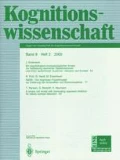Summary
In this article we describe a Situated Artificial Communicator for assembly tasks. The main components of the system we are developing are a speech understanding module and a two-arm-robot module. The robot system can be instructed using spontaneous speech. The speech understanding module is based on Combinatory Categorial Grammar, which makes incremental and interactive speech understanding possible. The robot module is provided with multiple sensors and it masters complex assembly operations like peg-in-hole or screwing a nut into a bolt. The architecture and the underlying cognitive principles enable interactive processing that depends on the actual situation and allows the system to take advantage of redundant items of information. Due to these principles our Situated Artificial Communicator is highly robust.
Zusammenfassung
In diesem Beitrag stellen wir einen Situierten Künstlichen Kommunikator vor, im vorliegenden Fall ein Robotersystem für Konstruktionsaufgaben. Das Robotersystem kann durch spontansprachliche Anweisungen gesteuert werden. Die Hauptkomponenten des Systems sind eine Sprachverstehenskomponente und eine Zwei-Arm-Roboterkomponente. Die Sprachverstehenskomponente basiert auf der Combinatory Categorial Grammar und ermöglicht eine inkrementelle und interaktive Sprachverarbeitung. Die Roboterkomponente verfügt über eine Vielzahl von Sensoren und beherrscht Montageoperationen wie Stecken und Schrauben. Durch die gewählte Architektur und die zugrundegelegten kognitiven Verarbeitungsprinzipien können Teilkomponenten des Systems der aktuellen Situation entsprechend interagieren und Informationsredundanz nutzen. Das System erhält dadurch eine hohe Robustheit.
Similar content being viewed by others
Literatur
Cipolla, R. & Hollinghurst, N. (1996). Human-robot interface by pointing with uncalibrated stereo vision. Image and Vision Computing, 14, 171–178.
Cipolla, R. & Hollinghurst, N. (1997). Visually guided grasping in unstructured environments. Robotics and Autonomous Systems, 19, 337–346.
Fink, G. A., Jungclaus, N., Ritter, H. & Sagerer, G. (1998). Integration verteilter Systeme mit DACS. Mustererkennung 1998, 20. DAGM-Symposium. Berlin: Springer.
Fodor, J. (1983). The modularity of mind.Cambridge, MA: Bradford.
Hildebrandt, B., Moratz, R., Rickheit, G. & Sagerer, G. (1995). Integration von Bild- und Sprachverstehen in einer kognitiven Architektur. Kognitionswissenschaft, 4, 118–128.
Hildebrandt, B. & Rickheit, G. (1997). Verarbeitung von Präpositionalphrasen in der Combinatory Categorial Grammar (Report 97/6 — Situierte Künstliche Kommunikatoren, SFB 360). Bielefeld: Universität Bielefeld.
Kessler, K., Hoffhenke, M., Rickheit, G. & Wachsmuth, I. (1999). Dynamische Konzeptverarbeitung mit imaginalen und assoziativen Strukturen. Kognitionswissenschaft, 8, 115–122.
Knoll, A., Hildebrandt, B. & Zhang, J. (1997). Instructing cooperating assembly robots through situated dialogues in natural language. Proceedings, IEEE Conference on Robotics and Automation, Albuquerque, New Mexico, April 1997. New Mexico: ICRA.
Peters, K., Strippgen, S. & Milde, J.-T. (1998). CoRA — An instructable robot. In T. Lueth, R. Dillmann, P. Dario & H. Wörn (eds.), Distributed Autonomous Robotic Systems 3 (pp. 247–256). Berlin: Springer.
Reinsch, M., Hildebrandt, B. & Zhang, J. (1998). RCRC- Ein flexibles System zur Spracherkennung (Report 98/11 — Situierte Künstliche Kommunikatoren, SFB 360). Bielefeld: Universität Bielefeld.
Rickheit, G. & Wachsmuth, I. (1996). Collaborative Research Center „Situated Artificial Communicators“ at the University of Bielefeld, Germany. Artificial Intelligence Review, 10, 165–170.
Scheering, C. & Knoll, A. (1998). Framework for implementing self-organized task-oriented multisensor networks. Proceedings of SPIE International Symposium on Intelligent Systems and Advanced Manufacturing, Vol. 3523, Boston, November 1998.
Sichelschmidt, L. (1995). Der Augenblick des Verstehens: Motorische Indikatoren unmittelbarer semantischer Verarbeitung (ZIF Mitteilungen). Bielefeld: Universität Bielefeld, 4/95, 3–15.
Spivey-Knowlton, M., Sedivy, J., Eberhard, K. & Tanenhaus, M. (1994). Psycholinguistic study of the interaction between language and vision. AAAI-94 Workshop on Integration of Natural Language and Vision Processing. Twelfth National Conference on Artificial Intelligence. Seattle, WA: American Association for Artificial Intelligence, 189–192.
Steedman, M. (1987). Combinatory grammars and human language processing. In J. L. Garfield (Ed.), Modularity in knowledge representation and natural-language understanding (pp. 187–205). Cambridge, MA: MIT Press.
Steedman, M. (1993). Categorial grammar. Lingua, 90, 221–258.
Steedman, M. (1996). Surface structure and interpretation. Cambridge, MA: MIT Press.
Weiß, P., Kessler, K., Hildebrandt, B. & Eikmeyer, H.-J. (1999). Konzeptualisierung in inkrementell-integrativer Sprachverarbeitung. Kognitionswissenschaft, 8, 108–114.
Wachsmuth, I. & Jung, B. (1996). Dynamic conceptualization in a mechanical-object assembly environment. Artificial Intelligence Review, 10, 345–368.
Zhang, J., Schmidt, R. & Knoll, A. (1999, im Druck). Appearance-based visual learning in a neuro-fuzzy model for fine-positioning of manipulators. Proceedings of the IEEE International Conference on Robotics and Automation, Detroit, MA, USA.
Zhang, J., von Collani, Y. & Knoll, A. (1998). Development of a robot agent for interactive assembly. In T. Lueth, R. Dillmann, P. Dario & H. Wörn (eds.), Distributed Autonomous Robotic Systems 3 (pp. 277–286). Berlin: Springer.
Author information
Authors and Affiliations
Corresponding author
Additional information
Diese Arbeit wurde von der Deutschen Forschungsgemeinschaft (DFG) im Rahmen des Sonderforschungsbereichs 360 gefördert.
Rights and permissions
About this article
Cite this article
Hildebrandt, B., Knoll, A., Scheering, C. et al. Ein Situierter Künstlicher Kommunikator für Konstruktionsaufgaben. Kognit. Wiss. 8, 137–142 (1999). https://doi.org/10.1007/s001970050083
Published:
Issue Date:
DOI: https://doi.org/10.1007/s001970050083




